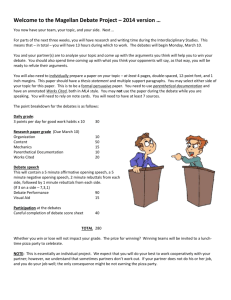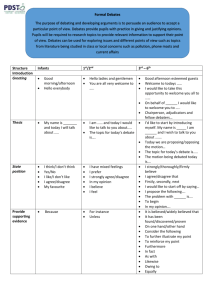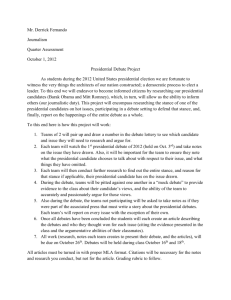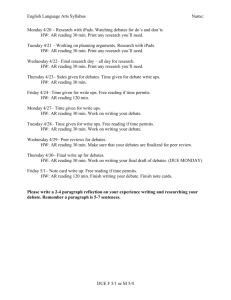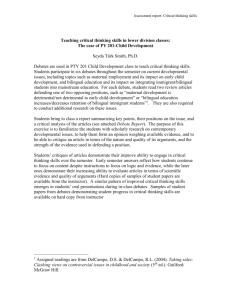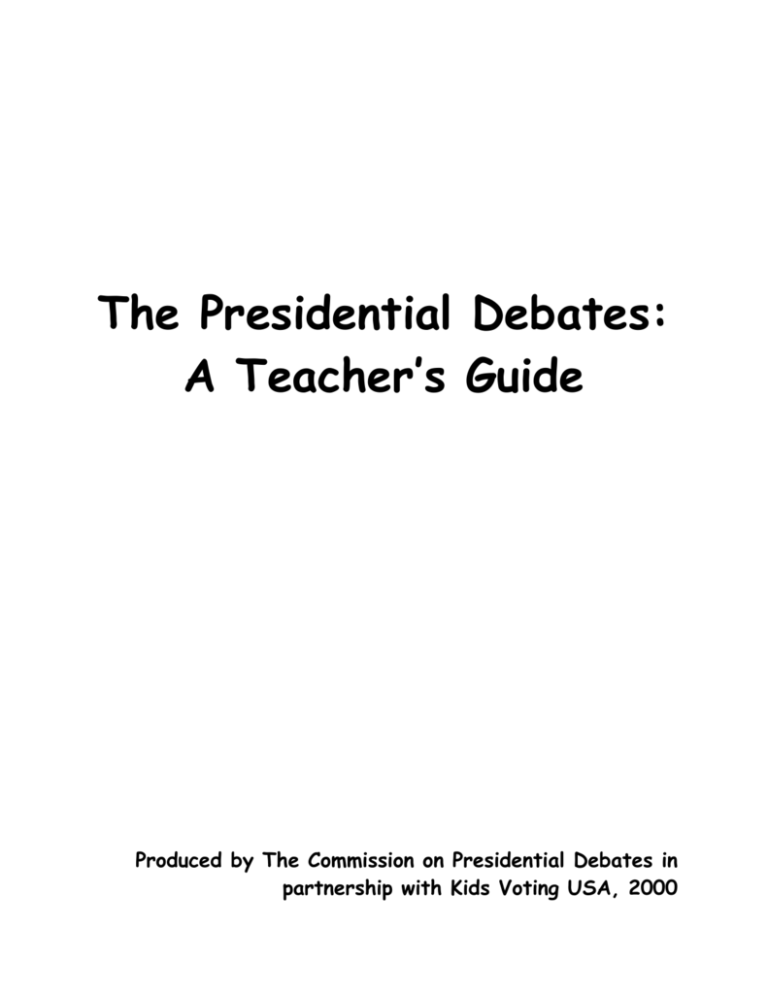
The Presidential Debates:
A Teacher’s Guide
Produced by The Commission on Presidential Debates in
partnership with Kids Voting USA, 2000
Introduction
What is a Debate?
A debate is a formal, oral contest between two individuals or teams who present arguments to
support opposing sides of a question. Debates follow a set of rules so that participants can state
their positions and attack their opponents’ views in a fair and orderly manner.
How Are Debates Used?
•
Forensic debates: Formal debates are held in schools or university debating societies as
exercises to sharpen thinking and speaking skills and to examine issues.
•
Legislative debates: The House of Representatives and the Senate debate a bill by
allotting fair procedures and equal time for arguments for and against the bill. The English
House of Commons was the model for this process. State legislatures have provisions that are
similar.
•
Political debates: For instance, the Lincoln-Douglas debates for the Senate seat in Illinois
in 1858 gave the first speaker 60 minutes, the second 90 minutes, and the first speaker 30
minutes at the end. They were festive occasions in the open air, with thousands in the
audience.
What’s the Recent History of Presidential Debates?
The first televised Presidential debates in 1960 provided the thin margin of victory for John F.
Kennedy in a very close election. Despite their popularity, no more debates were held for 16
years. They resumed in the Ford-Carter election in 1976. Since then, debates have been a
permanent and very important feature of presidential elections.
These activities were designed in collaboration with Kids Voting USA.
Overview of Activities
Elementary School Students
“Two Ballots”
Young people discover that they must gather and analyze information carefully or they could be fooled by
superficial slogans. They will use these critical skills when they watch the Presidential debates.
“Debate Bingo”
A 25-spot bingo card, for use as you watch the debates, provides opportunities for write-in topics predicted by the
child. Other spots are specific to key topics likely to be addressed by the candidates.
“The Voting Chain”
Vote with paper links to indicate which candidate appealed to you the most during the debate. Log onto
www.kidsvotingusa.org and www.debates.org for links to media websites. What were the analysis from media
organizations such as CNN, ABC, CBS, NBC, and the Washington Post?
Secondary School Students
“The Public Agenda”
Students collect and tally newspaper and magazine articles pertaining to the campaigns, and then predict topics that
will be addressed during the debates.
“It’s Your Turn to be a Political Reporter”
From the transcripts of former presidential debates come thorny questions on topics that are still hot, but also very
different, in the year 2000. Students write current questions for Presidential candidates, on nuclear weapons, the
environment, etc.
“Debate the Issue”
Forms, teaching strategies, and handouts for a formal classroom debate are provided.
“Solutions”
This lesson provides an organizer page for reflective analysis after all the debates have been concluded.
“Presidential Debate Scorecard”
Parents and older students review principles of logic and techniques of persuasion used by politicians. During the
debate, families record examples of “glittering generalities,” “bandwagon,” “name calling,” etc.
Useful Resources
See this section for websites and other information about debating in general and Presidential Debates in particular.
A Viewer’s Guide to Political Debates
This section provides tips on viewing political debates effectively.
Two Ballots
Objective
More!
Children experience voting with and
without adequate information.
Brainstorm topics for the two blank ballots
that children will use with the adults at
home. Example: Ballot A says “Fishing”
and Ballot B says “No fishing permitted on
our favorite lake.”
Get Ready
Ø Make a copy of “Two Ballots” and a
copy of “Two Ballots for Parents” for
each student.
Collect and display election articles,
pictures, or materials on a bulletin board.
Ø Cut the copies in half.
Vote
Vote Quote
Ø Without any instruction, give the
children Ballot A and ask them to vote
yes or no to each of the categories.
"Liberty without learning is always in
peril and learning without liberty
is always in vain."
Ø Tally the results.
-
John F. Kennedy
Ø Give the children Ballot B and ask
them to vote again. Tally the results.
Questions
What difference was there between
Ballot A and Ballot B?
Did you change your vote once you had
the information on Ballot B?
Why is it important to gather information
before we vote?
Where can we get information before
voting?
What kinds of information will we get by
watching the Presidential debates?
Copyright © 2000 Kids Voting USA, Inc. All rights reserved.
Two Ballots
Ballot Aiir
Ballot B ox
1. School
Yes
o
No
o
2. Recess
o
o
3. Ice Cream
o
o
4. Homework
o
o
5. Television
o
o
Yes
o
No
o
2. Recess will be
replaced by 20 minutes
of sit-ups & push-ups.
o
o
3. Only garlic flavored
ice cream will be served
in the cafeteria.
o
o
4. There will be no
homework on weekends.
o
o
5. Television will be in the
classroom - but only the
commercials.
o
o
1. School will be
year round.
Ballot A for Parentsi for parentsir Ballot B for ParentsfoParx
1.
Yes
o
No
o
2.
o
o
3.
o
o
4.
o
o
5.
o
o
Yes
1. ____________________
o
____________________
No
o
2. ____________________
____________________
o
o
3. ____________________
____________________
o
o
4. ____________________
____________________
o
o
5. ____________________
____________________
o
o
Copyright © 2000 Kids Voting USA, Inc. All rights reserved.
The Voting Chain
Objective
Participants vote with paper links and tally
the totals.
Get Ready
Ø Cut a small strip of construction
paper to make a link (in a chain) for
each voter.
Questions
Who has the longest chain?
Can you see your own voting link?
Would the chain look different if you had
not voted?
What might happen if you could vote as
many times as you wished rather than once?
Was this a good way to poll our opinions?
Ø Make a large sign with each debater’s
name on it. Include the candidate’s
picture if you can.
More!
Ø Mount the signs in a suitable place in
the home, school or public site.
A family or class could vote on other issues
during the week in this way or in another
way.
Make the Chain
Ø Ask each participant to attach a link
under the sign for THE
CANDIDATE WHO DID
HIMSELF/HERSELF THE MOST
GOOD in last night’s debate.
Ø Explain to young children that one
link represents one vote.
Copyright © 2000 Kids Voting USA, Inc. All rights reserved.
A community could display the voting chains
in a central public place, with a Visitors’
Book for comments on the debates.
The Public Agenda
Objective
Questions
Participants gather articles and classify media
coverage to determine national, state and local
issues agendas.
Different agenda items belong to different
levels of government. Were there issues that
belonged on the state or local agenda instead of
the national one? Are there "crossover" issues
that belong on all three?
Get Ready
Ø Obtain copies of one week's newspapers
and news magazines to form a resource
center for students/family members.
Ø Duplicate the Summary of the National
Political Awareness Test for each person.
Build the National Agenda
Ø Assign to each person the job of finding
three current articles from three different
sources (in newspapers, magazines or
from the Internet) about issues that the
American people think the federal
government should address.
Ø Pool the articles and count them to arrive
at a consensus on the top 10 items of
concern nationally.
Who are the "key players,” the most influential
people and groups that placed each item on the
national agenda? Who are the people and groups
most affected by that issue? Are the answers to
these questions identical? Why/Why not?
Are there items which you would like to place
on the national agenda? How could you help to
get them on the agenda if they are not already
there? Is this a part of activism?
Which agenda items will probably show up in
the presidential debates?
More!
Participants can use the Summary of the National
Political Awareness Test to see the national
agenda used in 2000 by Project Vote Smart, to
compare it with theirs. Which items from the
N.P.A.T. have risen to the forefront recently?
Continue to monitor changes and developments
in the national agenda by posting articles in the
10 areas chosen on a National Agenda Bulletin
Board in home or classroom.
Vote Quote
"Political parties serve to keep each other in
check, one keenly watching the other."
—Dwight D. Eisenhower
Topics Addressed in the Year 2000
Project Vote Smart
Presidential National Political Awareness Test
Project Vote Smart asks the Presidential candidates to fill out an extensive issues questionnaire.
Each category asks candidates to select and weight policy alternatives from large lists of possible
choices. We have enclosed only the question categories, which are excellent indicators to the
National Agenda.
H
Budget, Spending and Tax Issues
H
Defense Spending
H
Budget Surplus
H
Abortion Issues
H
Taxes
H
Campaign Finance Issues
H
Crime Issues (including death penalty, juvenile crime, and school violence)
H
Drug Issues
H
Education Issues (including standards and testing, vouchers, charter schools, grants and
funding, merit pay, tax incentives, etc.)
H
Employment and Affirmative Action Issues
H
Environmental Issues
H
Gun Issues
H
Health Issues (including medical research, Medicare, Patient’s Bill of Rights)
H
Immigration Issues
H
International Aid, International Policy and Trade Issues
H
Moral and Ethical Issues
H
Social Security Issues
H
Technology Issues
H
Welfare and Poverty
It’s Your Turn
to be a Political Reporter
Objective
Students review pressing questions on
topics from previous debates and then
decide what questions they would ask
the presidential candidates on these same
topics in the 2000 presidential debates.
Get Ready
Ø Duplicate a copy of the “It’s Your
Turn to Be a Political Reporter!”
worksheet for each student.
Ø After 10 minutes, ask students to
write each of their four questions on
the paper signs.
Ø When the questions have all been
posted, allow students to read the
signs and place a star or colored dot
in front of the question on each sign
that they think is most relevant.
Ø Label four pieces of butcher paper as
follows: “Nuclear Weapons,” “The
Environment,” “The Economy,” and
“Personal Style and Qualifications.”
Questions
Ø Mount the signs in the corners of the
room.
Which questions could never have
been asked in prior election cycles?
Play Political Reporter
How did members of the media frame
questions to trap a candidate or make
him/her look bad? What kinds of traps
do you foresee for candidates in 2000
debates?
Ø Review aloud the questions asked by
reporters in 1960, 1976, 1980, and
1988. Students may need some
background information, best
delivered by the teacher or
discovered through research teams.
Ø Explain that the situations have
changed drastically over the years,
but that the topics addressed are still
important to the public.
Ø Ask students to formulate one
relevant question for each topic that
would be good to ask in the
presidential debates this fall.
(Example: “What would you do
Ø about nuclear weapons testing in
India and Pakistan?” for “Nuclear
Weapons.”)
Are any of the best questions similar
to the ones asked in earlier years?
Will online reporting increase or
decrease voter participation?
What did this exercise make you think
about the political power of the media?
Vote Quote
“Both scholars and pundits agree that Nixon won
the debate on radio, but most important is that
Kennedy won on the emerging medium,
television. (1960) The question I pose to you
today is, who will win online in 2000?”
-Steve Case, CEO, America Online
Copyright © 2000 Kids Voting USA, Inc. All rights reserved.
It’s Your Turn to be a Political Reporter!
Topic: Nuclear Weapons
Debate: Kennedy/Nixon, October 21, 1960, ABC Studios, New York, New York
Reporter: John Chancellor, NBC News
Question: (to Senator Kennedy): “…should the United States resume nuclear testing, and if
the Russians do not start testing, can you foresee any circumstances in 1961 in which
the United States might resume its own series of tests?”
Your question on nuclear weapons for the 2000 presidential debates:
______________________________________________________________________________
______________________________________________________________________________
Topic: The Environment
Debate:
Carter/Ford, September 23, 1976, Walnut Street Theater, Philadelphia, Pennsylvania
Frank Reynolds, ABC News
Question: (to Governor Carter): “Well, Governor…would you require mandatory conservation
efforts to try to conserve fuel?”
Reporter:
Your question on the environment for the 2000 presidential debates:
______________________________________________________________________________
______________________________________________________________________________
Topic: The Economy
Debate: Carter/Reagan, October 28,1980, the Public Music Hall, Cleveland, Ohio
Reporter: Harry Ellis, the Christian Science Monitor
Question: (to President Carter): “Mr. President, when you were elected in 1976, the Consumer
Price Index stood at 4.8%. It now stands at more than 12%…Can inflation in fact be
controlled?”
Your question on the economy for the 2000 presidential debates:
______________________________________________________________________________
______________________________________________________________________________
Topic: Personal Style and Qualifications
Debate: Bush/Dukakis, October 13, 1988, Pauley Pavillion, UCLA, Los Angeles, California
Reporter: Margaret Warner, Newsweek magazine
Question: (to Governor Dukakis): “The American public admired your performance [in the first
debate], but doesn’t seem to like you much. Now, Ronald Reagan has found his
personal warmth to be a tremendous political asset. Do you think that a president has
to be likeable to be an effective leader?
Your question on a President’s personal style and qualifications for the 2000 presidential
debates:
______________________________________________________________________________
_____________________________________________________________________________
Debate the Issue
Objective
Students debate a topic in the election to examine
democratic ideas.
Get Ready
Ø Generate a resolution for the debate.
Presidential campaign issues will lead you
to a topic, and the class may vote together
on a choice of resolution.
Ø Phrase the resolution in the affirmative:
"Resolved: that our state must better fund
education."
Ø Select two teams of four students.
Ø Make ten copies of the “Debate
Format/Ballot,” one for each of the eight
debaters and two for yourself. (You will
make a full classroom set of ballots when
parts have been chosen and it’s time for the
classroom debate.)
Ø Make multiple copies of the “Presidential
Debate Scorecard.”
Ø Locate a stopwatch.
Debate!
Ø On Day 1, assign 4 students to each team.
Ø Assignment for the rest of the class:
Practice writing statements with the 10
Techniques of Persuasion/Logical
Fallacies, using the Debate Scorecard.
Copyright © 2000 Kids Voting USA, Inc. All rights reserved.
Ø Ask team members to choose parts. The
opening argument may be prepared in
advance, whereas it is difficult to do so for
the question session.
Ø Tell debaters to keep their ideas on two
pages of cards: "Our Arguments” and "If
They Say ____, We Say ____." Prompt the
affirmative and negative teams to write
down at least one entry on each page while
you are coaching each team for a few
minutes. Students will finish preparations
for homework that night.
Ø Duplicate ballots with names filled in for
Debate Day.
Ø Day 2: Hand out the ballots and hold the
debate, enforcing time limits. Have students
circle the winning side and list the most
convincing argument, but tell them to leave
their names off the ballots. Read the most
convincing arguments as the debate ballots
are tallied.
Questions
Which debate arguments impressed you most and
affected your decision on the issue?
Was it difficult to separate argument values from
performance and personality aspects? How does
this relate to Kennedy/Nixon or Bush/Clinton?
Is this an effective format to discuss democratic
ideas? Why? Why not?
More!
Students will use the Debate Scorecards to evaluate
the Presidential debates on TV, applying the same
criteria they used with their peers.
Debate Format and Evaluation
TOPIC "Resolved: that
"
Debate Team Members
Affirmative Team
Negative Team
1.
2.
4.
3.
5.
6.
7.
8.
Sequence of the Debate
Follow the numbers for proper order of speakers.
Affirmative Team
1.
4.
5.
7.
Opening Statement
Rebuttal Argument
Question Session
Summary
Suggested Time
3 min.
3 min.
*5 min.
3 min.
Negative Team
Suggested Time
2. Opening Statement
3. Rebuttal Argument
6. Question Session
8. Summary
3 min.
3 min.
*5 min.
3 min.
*Debater answers four questions, one from each member of the opposite team, and if there is time also answers
questions from the floor.
Ballot
The winning team was (circle one):
AFFIRMATIVE
NEGATIVE
This team won the debate because:
Student Tips for Selecting the Winning Team
H List at least one argument that convinced you that one side was more effective than another.
H Try to be objective in your decision, by ignoring everything except the ideas presented. In making your choice,
you may consider only the evidence and logic that is actually presented during this debate. Try to use only
information that you hear in the debate, rather than information that you have already had. Remember, you are
judging the relative strength of each team's arguments, not your personal opinion.
Copyright © 2000 Kids Voting USA, Inc. All rights reserved.
Solutions
Objective
Questions
Students gather information to prepare to vote.
How do you feel about Candidate A's
solutions?*
How do you feel about Candidate B's
solutions?*
Did any of your solutions match those of a
candidate?
Might this be a good reason to vote for a
candidate?
What should/could you do if you feel you have
a good idea for a solution?
Who would you vote for, considering the issues
on the activity sheet?
Getting Ready
Copy activity sheet “We Elect Leaders to Help
Solve Society's Problems” for each student.
Gather Information
Ø Assign students to watch all four of the
Presidential debates, recording each
candidate’s views on the “We Elect
Leaders…” page.
Ø In discussion, ask students what they
consider to be their society's, community's,
state's or nation's greatest problems. Have
students list them on the activity sheet.
Ø As they learn the views of the candidates
during the presidential debates, have them
list those views on the activity sheet. Have
students list their own solutions to the
problems.
Ø Ask students to put an asterisk by one
problem they could work on now.
More!
Make an election scrapbook. Collect articles,
cartoons, etc., and place them in the scrapbook.
You might consider donating it to the school
library upon completion to serve as a historical
document.
Vote Quote
"I know of no safe depository of the ultimate
powers of society but the people themselves; and
if we think them not enlightened enough to
exercise their control with a wholesome
discretion, the remedy is not to take it from them,
but to inform their discretion by education."
- Thomas Jefferson
*The CPD will not apply its three selection criteria until late September, at which point the participants will be invited to the
debate.
Copyright © 2000 Kids Voting USA, Inc. All rights reserved.
We Elect Leaders to Help Solve
Society's Problems
Problems
A's Solutions* B's Solutions* Our Solutions
Economy
Pollution
Violence
*The CPD will apply its three selection criteria in late September, at which point the participants will be invited to debate.
Debate Scorecard: Techniques of Persuasion
Politicians’ most powerful arguments can be misleading. In fact, research shows we’re often
swayed by faulty logic. As you listen to the presidential candidates debate the issues, give them
the “logic check-up.” If you catch a candidate using one of these techniques, record the
examples in the spaces provided.
Techniques
Candidate A
Candidate B
Candidate C
Appeal to Emotion
Bandwagon
Card Stacking
False Cause
False Dilemma
Glittering Generalities
Hasty Generalization
Name Calling
Slippery Slope
Testimonial
H
H
H
H
H
H
H
H
H
H
Appeal to Emotion: Summons fear, anger or pity to secure listener support.
“If we don’t fight crime my way, your child won’t feel safe walking the streets.”
Bandwagon: Encourages the listener to do something because it’s the popular thing to do.
“More and more of us want new blood in Washington, and we’re voting for Jones.”
Card Stacking: Presents the evidence in a partial or slanted way.
“The average income is rising” - technically correct, but only the top 10% incomes are up.
False Cause: Insists that one event caused the other just because it came first.
“As soon as Jones was elected, savings banks began to fail.”
False Dilemma: Poses only two choices when there are a variety of possibilities.
“Choose Smith and you’ll get inflation; choose Jones and the budget will be balanced.”
Glittering Generalities: Says little specifically, but conveys emotion.
“John Jones has made this nation a better place.”
Hasty Generalization: Bases a conclusion on insufficient evidence.
“Dropping out of school must be a problem because I saw an article about it.”
Name Calling: Uses negative labels to stigmatize opponents.
“My opponent is a card-carrying liberal.”
Slippery Slope: Claims that an event will lead to an uncontrollable chain reaction.
“First they outlaw machine guns, and then they’ll take your hunting rifles.”
Testimonial: Convinces only through the endorsement of a respected personality.
“If he’s okay with General Colin Powell, then he’s okay with me.”
Copyright © 2000 Kids Voting USA, Inc. All rights reserved.
Useful Internet Resources
On Debating:
http://debate.uvm.edu
Debate Central – “Everything about Debates and Debating”
http://debate.uvm.edu/nfl.html
National Forensic League – Home page of the national U.S.
high school debating organization
http://debateamerica.org
“How to Debate,” “Create Your Own Debate,” etc.
On Election 2000 Political Debates and Policy Resources:
http://www.debates.org
The Commission on Presidential Debates website contains
information to form a DebateWatch 2000 group, links to sites
related to education, and a complete set of the transcripts from
every Presidential debate since 1960.
http://www.lobbyforme.com
Politics1.com’s Directory of Political Debates and Issues –
contains hundreds of online resources for debates on many
popular issues, all from online magazines, newspapers and
journals.
http://www.publicagenda.com
Public Agenda’s Issues Digests are a gold mine for teachers
planning a secondary school classroom debate; includes
“Issues Overview,” “Fact File,” a digest of recent news stories,
and “Framing the Debate: 3 Viewpoints” for each topic.
On Historic Debates in the United States:
http://debateinfo.com/
The “Hall of Fame” section of this site contains excerpted
transcripts of the Lincoln/Douglas and Kennedy/Nixon
debates.
http://lcweb2.loc.gov/ammem/amlaw/lwed.html
The Library of Congress’ “American Memory” site includes
the debates in state legislatures over adopting the United States
Constitution in 1787 – a great tie-in to the Presidential debates
for U.S. history classes studying this era.
http://www.cspan.org
C-SPAN’s pages on the Presidents contain information about
20th century debates, and its online service will archive sections
of the Presidential debates in 2000 to replay in the classroom or
computer lab.
A Viewer’s Guide to Political Debates
Voters typically identify candidate debates as the most influential source of information received
during a campaign. Because of their importance, this guide describes commonly used debate
formats, questioning techniques, and guidelines for viewing a debate. It is designed to be useful
in viewing presidential, state, and local debates.
The Structure of Debates
Debates use a variety of formats. Since 1992, the general election presidential debates have also
featured multiple formats including a town hall meeting with citizen questioners.
Most debates impose time limits on answers to ensure that all candidates have equal opportunity
to respond. The debates may focus on a wide range of issues or may target a particular theme
such as education or the economy. General election presidential debates usually divide the time
between foreign and domestic topics.
Candidates may have an opening statement, or a moderator may introduce each candidate and
begin questioning immediately. In most debates, candidates have closing statements.
Questions guide the content of debates. There are three types of questions: initial, follow-up, and
cross-examination. Initial questions get the debate started by asking candidates to explain or
defend a position or compare it to an opponent’s Initial questions may be hypothetical, phrased
in the form, “What would you do if...?” Follow-up questions are directed at a candidate after an
answer is given. Their purpose is to probe the original response by asking for elaboration or
clarification. Follow-up questions may be asked immediately after an initial response is given or
after all candidates have answered the initial question. Cross-examination questions are asked by
one candidate to another. A separate time can be set aside for cross-examination questions or
they may be included as follow-ups.
Questions may be posed to candidates from a variety of sources. In primary and local debates,
experts on the topic debated may serve as panelists. A single moderator, usually from the media,
or a panel of media representatives or subject experts are the most common questioners. Many
debates, especially at the local level, allow for questions from the audience at some point in the
debate. The Richmond town hall meeting in 1992 was the first general election presidential
debate to involve citizen questioners.
How to get the most out of a political debate:
Focus your attention on a few key points. Know what it is you want in an office holder, then
watch and listen to see which candidate best fits your ideal. The following suggestions will help
guide you:
•
•
•
•
•
•
•
Set aside your partisan views. Listen to the debates to learn as much as possible about all
candidates and their positions.
Pay close attention to the candidates when they talk about how to solve problems. Listen
carefully for comparisons candidates make between or among their programs and their
opponents’.
Identify the candidate’s debate strategy. Does the candidate speak directly to the issues,
provide specifics, and present new policies or information? Does the candidate evasively
answer questions to suit his/her agenda?
Identify the images which candidates try to create for themselves. Most candidates try to
portray themselves as leaders and identify themselves with cherished American values while
suggesting that their opponents lack these qualities. What in the responses supports their
claims?
Be aware of the technical limitations of televised debates. Television works by showing
action. To create action and minimize monotony, directors sometimes include “reaction
shots” to show one candidate’s response to an opponent’s statement. This can draw your
attention away from what is being said. It is wise to remember the role of action shots when
watching the debates.
Consider the questions asked by the panelists. The essence of the debate is comparison and
contrast. How do the questions themselves shape the debate?
Don’t watch a debate to determine a winner or loser. Instead, evaluate each candidate
according to your own personal ideas and standards. Focus on the question, “Who would
make a better president, senator, governor, legislator, county clerk?”
About this Guide
This guide was adapted from material by the following National Communication Association members: Diana
Carlin, University of Kansas; Robert Friedenberg, Miami University; Hamilton, OH; James Guadino, Speech
Communication Association; Susan Hellweg, San Diego State University; John Morello, Mary Washington College;
Michael Pfau, University of Wisconsin.


